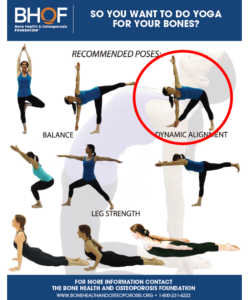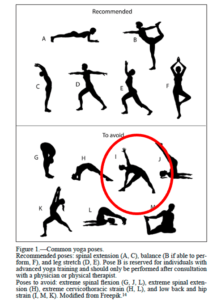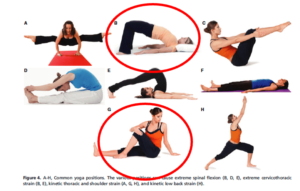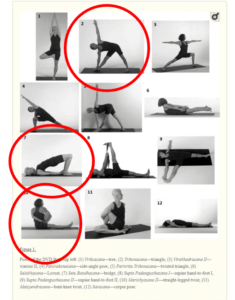
28 May What yoga poses should I do or not do since I have osteoporosis?
This is a perpetual question:
“What yoga poses should I do or not do since I have osteoporosis?”
When you seek an answer from different bone health experts you get conflicting responses.
This causes so much confusion and frustration.
Here are just a few examples of what you find:
Sherri Betz PT includes Triangle as an example of a recommended pose for “dynamic alignment” on her handout that Bone Health & Osteoporosis Foundation (BHOF) uses:

But researchers from the Mayo Clinic published a case series on vertebral compression fractures (VCF) associated with yoga and put Triangle on the Avoid side of of their lists (image below) due to their assessment that it causes “low back and hip strain” (which, to me, is almost as odd as Sherri including Warrior 1 on her “Avoid” list because, as she said on an episode of The Bone Coach podcast, “it causes knee strain.” Hmmm…maybe? But both of these poses can be modified to avoid these strains…more on that in a minute.)

Another case study on VCFs from Mayo Clinic includes Bridge and Seated Twist on their list of common poses to be fearful of due to their “extreme” positioning (as an aside, I’m not sure why they include a pillow under the head in Bridge):

Yet Dr. Fishman used both these two poses (with no pillow for bridge) – and Triangle in his study and said there were no adverse effects or fractures:

Speaking of Dr. Fishman’s study, many exercise specialists critique the 12 poses in his study either for their perceived danger or their perceived ineffectiveness for building bone mineral density (primarily as compared to the LIFTMOR randomized controlled trial.) The Fishman observational study has a lot of drawbacks for sure, but, at the same time, there are thousands of people who do Dr. Fishman’s protocol of poses with self-reported success and benefit.
How tightly do we adhere to scientific evidence over individual experience?
“Wherever you put the mind, the body will follow.”
~ Ellen J. Langer, PhD, researcher & author of Mindfulness
The work on Mindset matters: exercise and the placebo effect of Ellen J. Langer at Harvard might provide the argument that the power of placebo could, in part, be working in the instances of someone doing yoga poses mindfully with the belief that it is helping their bones.
Long-held beliefs can have a powerful hold and be difficult to change.
With this in mind, we should be careful not to just parrot nocebic messages like the “danger” of some poses on our spine, especially when those long-held beliefs are actually based on outdated science.
I wrote about the almost universal fear of “rounding” your spine in another blog: “Don’t Round Your Spine!” they say… This is a party-line that needs to stop, especially when talking about yoga.
We know more now than we did 40 years ago when the study on Flexion vs Extension Exercises by Dr. Mersheed Sinaki of the Mayo Clinic was published that fueled the warning against spinal flexion. Like the Fishman study, there are many drawbacks to her study not the least of which is that it included only 59 people and all >with pre-existing vertebral fractures <. Only nine of them were assigned (not randomly by the way) to the flexion exercise group to do old-fashioned abdominal crunch sit-ups and an unsupported spinal stretch. Eight of the nine were found to have more VCFs on follow-up, which was anywhere from one to six years later. Is this causation or correlation? We know now that once you have a VCF you are more likely to have another VCF. (If you’re interested in dissecting the flaws to this study more you can check out this podcast that came out recently.)
I’ll just underscore here that from all that we’ve learned in the last 40 years, the current BoneFit(tm) Movement Guidelines have been revised to not AVOID our natural spinal flexion but to LIMIT flexion movements of the spine that have these qualities to them: “repeated, sustained, weighted, end-range, rapid, and forceful“.
There really are very few yoga poses that I can think of that even come close to those qualities (unless you are doing some sort of intense fitness-based hot yoga fusion workout.)
It’s very scary to think of breaking a vertebrae, so it’s understandable to think that promoting caution, even in its extreme, is not a bad thing. However, if we don’t move the spine there are consequences to our longevity and health. Unnecessary caution is not beneficial to those whose fracture risk is low. Osteoporosis is a broad diagnosis on that front. And fracture risk varies.
So why do these discrepancies exist across bone health experts regarding which poses are safe or not if you have osteoporosis?
One reason is adherence to that (overly) cautionary tale about flexion based on old and faulty science.
The other main reason, though, is that the lists are made by people with varying degrees of yoga experience themselves and varying degrees of understanding how to teach the Yoga beyond the poses.
So…back to the question: what yoga poses should you do or not do if you have osteoporosis?
The answer must begin with some questions about your individual circumstances.
A few might be:
- Have you fractured? (when? what part of body?)
- Has your fracture healed?
- Do you exercise regularly?
- Have you done yoga before?
- How familiar are you with how to do poses and align your body well?
- What other conditions or issues or injuries are you dealing with?
- And – can you breathe? This is no joke. The breath is, I believe, the KEY to doing yoga safely if you have osteoporosis.
In other words, the truth is:
Yoga is not one-size-fits-all (and neither is osteoporosis.)
A list or pictures of specific poses you “should” or “should not do” (with any condition frankly) may be well-intentioned but is very misleading.
A generic list or set of pictures isn’t personalized to your situation and capabilities.
A list or pictures of poses isn’t even an accurate representation of the practice of Yoga!
The question really is…
“How do you practice yoga while living with low bone density?”
My answer for you would consider your unique situation and these points:
The mechanics of a pose shape can (and should) vary person to person (“safety” is implied regardless of bone density diagnosis.)
Slower and more mindful practice is probably a better way to do yoga as we grow older anyway and will give you the opportunity to explore better options for a safer experience.
A Bone-Informed and experienced yoga teacher or yoga therapist can guide you. Let them know the answers to the questions above and they will help you find the intersection between the intended function of the pose and your abilities (i.e., physical fitness as well as your capacity to concentrate and be self-aware) while accounting for an appropriate level of caution regarding your bone fracture risk.
Yoga should not be a game of Simon says (even if Simon is claiming to keep you “safe” from those “dangerous” poses. You Are the Pose!)
Modifying a pose is learning how to steer the experience with your own agency & responsibility.
Learning how to pay attention to your breath as taught in the Viniyoga tradition is especially supportive of your spine.
Yoga is way more than just the poses (and I like to think of it as an elaborate ruse to get you to breathe 😉)
Practicing yoga safely and wisely for your bones takes practice. Over time you learn about yourself. You become stronger and more flexible in your body and mind. Your relationships with yourself and the world around you improve.
And in this environment, your bone health plan can thrive.
~~~
Join me for Yoga for Our Vital Bones
It’s breath-centered and bone informed yoga for safe & wise movement both on and off the mat.
Register here.
~~~




No Comments